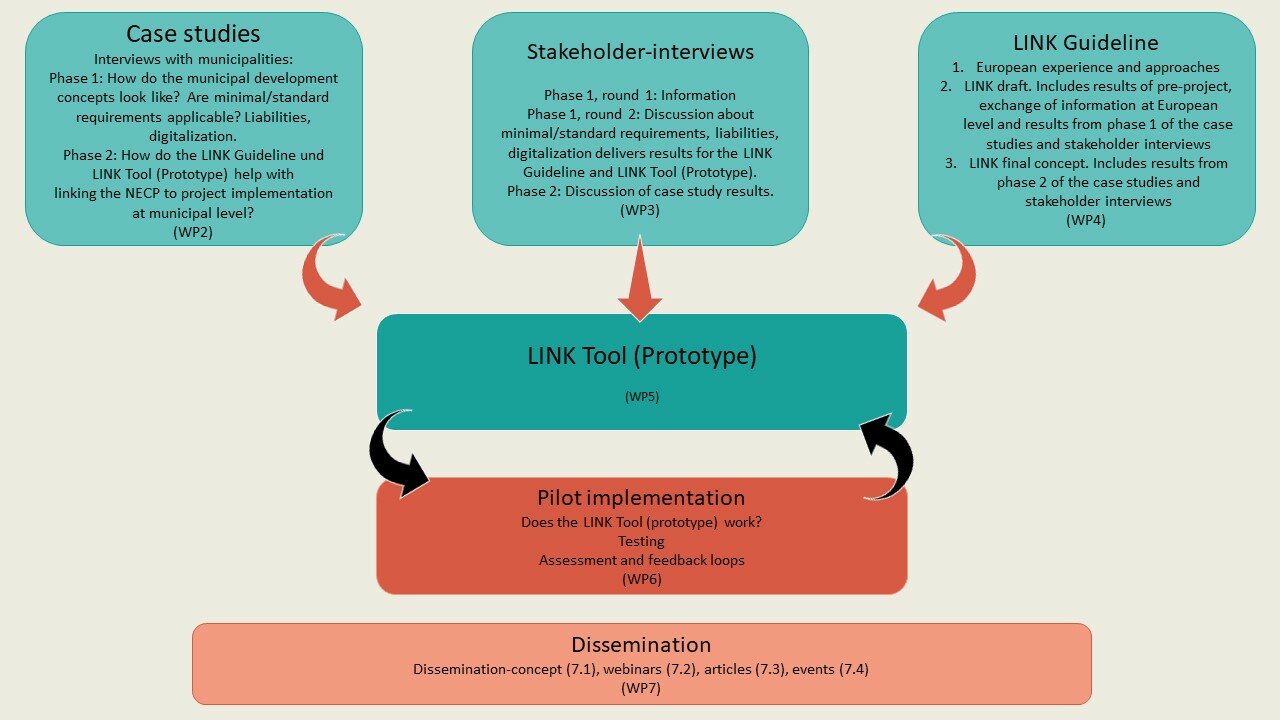What the project is about
Project description - What is transFORMAT-LINK?
transFORMAT-LINK. Supporting the transformation process: Linking NECP planning and reporting with project implementation at municipal level.
Research project funded by ACRP - 14th Call, 2022, Climate and Energy Fund.
Project duration: 10/2022-09/2024.
Project objectives - What does transFORMAT-LINK change?
transFORMAT-LINK supports municipalities in the preparation and revision of their municipal development concepts. The aim is to bring the municipal development concepts as far as possible in line with the objectives of the Austrian National Energy and Climate Plan (NECP).
Austrian municipalities have
considerable scope of action in shaping municipal spatial
planning, which offers many opportunities to implement energy-
and climate-relevant content in a meaningful way. For example:
a municipality can define areas with preferential use of
certain types of renewable energy and designate these areas
transparently. This facilitates the realistic assessment of
potential for project development and to realize this potential
through financing in accordance with the EU criteria for
sustainable investments (Taxonomy Regulation).
The municipal development concept (sometimes referred to as the municipal development plan) provides the guideline for municipal development over the next ten years. It serves as a basis for zoning and construction planning and last but not least for energy planning.
transFORMAT-LINK elaborates minimum requirements for municipal development concepts to make the best use of renewable energy potentials and to consistently avoid maladaptation to climate change.
Project background - Why does transFORMAT-LINK exist?
The National Energy and Climate Plan (NECP) is the key policy instrument to ensure that the goals of the five dimensions of the Energy Union are achieved by 2030.
The importance of renewable energy for achieving the energy and climate goals is obvious. With regard to the availability of renewable energies, there are spatial dependencies and thus possible conflicts of objectives in the use of space, for example with nature conservation and the preservation of biodiversity. Challenges for spatial planning arise, in particular as a result of the division of tasks between the federal, state and municipal governments.
In the Austrian NECP 2019, spatial planning was mentioned as an important instrument without providing more detailed information. The main question was therefore how this situation could be improved with regard to the link between the federal government (national planning and reporting level of the NECP) and the municipalities (local project implementation level).
Project structure – How does transFORMAT-LINK work?
The project is divided into the following work steps.
- Case studies with municipalities - Which possibilities are there to consider energy and climate objectives in the municipal development concept?
Selection of municipalities with >50,000 inhabitants as case studies. Analysis of local planning instruments regarding their energy and climate relevant statements and specifications with special focus on municipal development concepts. Assessment of possible effects with regard to the achievement of the objectives of the National Energy and Climate Plan (NECP).
- Stakeholder-Interviews - Who has the responsibilities for meeting the NEKP requirements?
Stakeholder interviews with federal, state and local levels of government.
- LINK Guideline - What are recommended actions for municipalities for the revision of their municipal development concept?
Derivation of approaches and recommendations for municipalities from the case studies and stakeholder interviews. Preparation of a catalog of minimum requirements for the revision of municipal development concepts. Processing of the recommendations and minimum requirements in the LINK Guideline. The LINK Guideline is an assistance for municipalities regarding the development and achievement of the NECP goals, the planning and reporting according to the NECP and the development of renewable energy projects in the municipality.
- LINK Tool (prototype) - The tool for low-threshold application of the recommendations for action
The LINK Tool prototype
version offers an easy-to-understand web interface in versions
for
1) the interested public,
2) experts in the municipalities and
3) the higher-level administration.
- Selected municipalities - testing the LINK Tool (prototype) in practice
Testing and feedback loops with two Austrian pilot communities.
- Dissemination - Making the project and its results known
A broad dissemination of the LINK guideline and the LINK Tool (prototype) at face-to-face events and online (internet, webinars, and publications) creates added value in the communities and climate-compatible municipal development concepts in line with the NECP.
